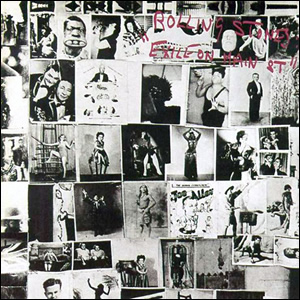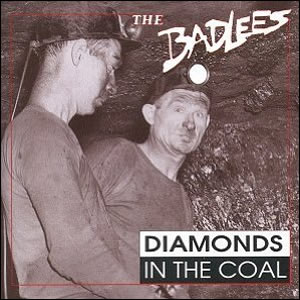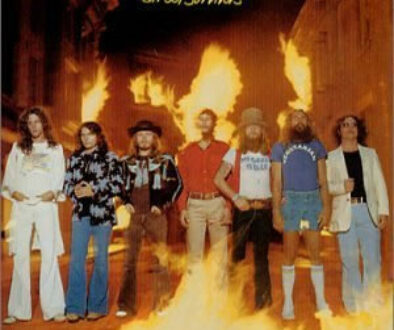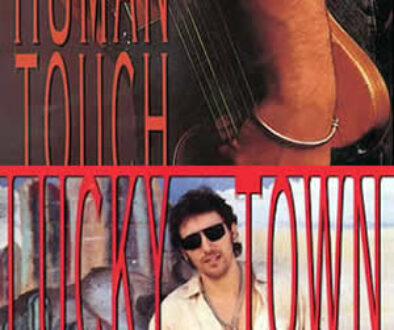Exile On Main Street by The Rolling Stones
 Many esteemed and big-name rock publications have rated Exile On Main Street by The Rolling Stones as one of the greatest albums of all time (especially the publication which bears the same name as the band). Honestly, this fact may expose the single most egregious display of “group think” in the rock world or at the very least, a floating declaration that has gone unexamined for about 40 years. While the music is legitimate rock throughout, this 1972 double album pales in comparison to its predecessor, 1971’s single LP Sticky Fingers, while maintaining much of the same musical direction. In fact, there is very little new ground broken on Exile On Main Street, which fails to provide much stylistic variation among its four sides and seriously lacks top notch production quality. The album also presents a lack of band integrity, as many sessions featured outside players taking on prominent roles in the recordings.
Many esteemed and big-name rock publications have rated Exile On Main Street by The Rolling Stones as one of the greatest albums of all time (especially the publication which bears the same name as the band). Honestly, this fact may expose the single most egregious display of “group think” in the rock world or at the very least, a floating declaration that has gone unexamined for about 40 years. While the music is legitimate rock throughout, this 1972 double album pales in comparison to its predecessor, 1971’s single LP Sticky Fingers, while maintaining much of the same musical direction. In fact, there is very little new ground broken on Exile On Main Street, which fails to provide much stylistic variation among its four sides and seriously lacks top notch production quality. The album also presents a lack of band integrity, as many sessions featured outside players taking on prominent roles in the recordings.
The album featured material which was written and recorded between 1968 and 1972, with the bulk being done in the basement of a rented a villa called Nellcôte in France, while the band was on “tax exile” from their native England in late 1971. The loose plan was to sleep all day and record all night, but this loose setting and arrangement bred a rash of no-shows throughout the recording process, in which case band members and other players would fill in on instruments they may have not naturally played. Producer Jimmy Miller filled in on drums for a few tracks, while several players filled in on bass for Bill Wyman, who only played on about half of the tracks.
The resulting album is murky and raw, with the vocals of lead singer Mick Jagger often buried in the mix. While this is not terrible in of itself, it grows old over the course of 18 album tracks. Jagger has been critical of the album through the years, stating at the time of its release;
“It’s very rock & roll, you know. I didn’t want it to be like that. I’m the more experimental person in the group, you see I like to experiment. Not go over the same thing over and over…everyone knows what their roots are, but you’ve got to explore everywhere…”
Apparently, much of the rock press expressed similar apprehension about the album at the time of release, but these mainstream critics have largely done an about-face and morphed in with the “all time greatest this” or “all time greatest that” party line.
 Exile On Main Street by The Rolling Stones |
|
|---|---|
| Released: May 12, 1972 (Rolling Stones) Produced by: Jimmy Miller Recorded: Various Locations, June 1969–March 1972 |
|
| Side One | Side Two |
| Rocks Off Rip This Joint Shake Your Hips Casino Boogie Tumbling Dice |
Sweet Virginia Torn and Frayed Sweet Black Angel Loving Cup |
| Side Three | Side Four |
| Happy Turd On the Run Ventilator Blues I Just Want to See His Face Let It Loose |
All Down the Line Stop Breaking Down Shine a Light Soul Survivor |
| Group Musicians | |
| Mick Jagger – Lead Vocals Keith Richards – Guitars, Vocals Mick Taylor – Guitars Bill Wyman – Bass Charlie Watts – Drums |
|
Jagger and guitarist Keith Richards wrote the bulk of the material. The first of the four sides may actually be the weakest on the album. It starts with the decent loose jam “Rocks Off”, a sound later echoed by Aerosmith on their album Draw the Line, but then devolves into the very average rockabilly of “Rip This Joint”. Both feature the rock piano of Nicky Hopkins, who had worked with the stones on past projects. The Slim Harpo cover “Shake Your Hips”, brings back a sound reminiscent of the band’s earliest blues material, but by the time we get to “Casino Boogie”, Jagger’s strained vocals start to wear thin on the listener and the album’s flow seems to be nonexistent.
“Tumbling Dice” is probably the most popular song from Exile, with lyrics that tell a story about a gambler. The song was originally slated for Sticky Fingers, and features band manager Ian Stewart on piano and second guitarist Mick Taylor filling in on bass for Wyman.
The second side is probably the best of the four, starting with the country-inspired “Sweet Virginia” where drummer Charlie Watts plays a nice shuffle and a saxophone solo is provided by Bobby Keys. Lyrically, this song is both folksy and frank;
“But come on come on down sweet Virginia / come on honey child I beg of you
Come on come on down you got it in you / got to scrape that shit right off your shoes…”
“Torn and Frayed” sounds like it landed just short of being great, just a tad too unorganized and under-cooked to be taken very seriously. Still, it contains a great slide guitar by Richards and organ by Jim Price above the three-chord honky-tonk. “Sweet Black Angel” hearkens back to the sound on 1967’s Between The Buttons and is one of the few tracks on this album to feature all five Rolling Stones playing their appropriate instruments. Unfortunately momentum is lost with “Loving Cup”, which slides back to the predictable and mundane sound of the first side.
“Happy” features Richards vocals and is a refreshing change-up in ways, with crisp brass accenting this second single from the album which reached the top 40 in the charts. Keys prides saxophone and percussion, while Jim Price adds trumpet. “Ventilator Blues” was co-written by Taylor, the only song on the album which a member of the Stones besides Jagger and Richards gets a songwriting credit. “I Just Want to See His Face” commences with a bad fade in from “Ventilator Blues” and is yet another exhibit of a very average piece being lauded. It is a repetitive and (slightly) improvised piece with some gospel influence, but not much more. “Let It Loose” starts with a different sound of effect-heavy guitar riff but this is the only really interesting part of the song, which once again seems undercooked and weakly composed.
The final side of the album begins with “All Down the Line”, again the same exact song over again save for Taylor’s interesting slide. The Robert Johnson cover “Stop Breaking Down” reveals an embarrassing gap in composition quality between much of the original material and this (then) 35-year-old song. “Shine a Light” is the last good song on the album, perhaps best song on the album. This piano ballad that is focused yet soulful and features the fantastic organ and piano work by Billy Preston and great backing vocals by Clydie King and Vanetta Fields. It was written mainly by Jagger back in 1968 about then-band member Brian Jones’ addiction to drugs and detachment from the rest of the band, but was left off the Beggars Banquet from that year. “Soul Survivor”, another really uninspired song, finishes off the side and the album.
Beatles producer George Martin has opined that their double “White” album may have worked better as a really good single album. That sentiment is multiplied and on steroids with Exile on Main Street, which would have worked best is saved for some future “basement tapes” collection. As a proper album of this great era, it is extremely average and definitely not the desert island record that so many had deemed it to be.
~
Part of Classic Rock Review’s celebration of 1972 albums.





July 27, 2016 @ 5:29 pm
It’s hard to appreciate the greatness of this album when your head is firmly planted between your gluts! The energy level of these songs is off the charts and are some of the best recordings the Stones ever made! Mick Tayor and Keith Richards provide killer riffs and flashy solos all over the album. Charlie and Bill show why they are considered by many to be “the best rhythm section in the world” and Jagger is in fine voice throughout! What difference does it make that other musicians played on some of the songs? Mick and Keith wrote most of the songs and the rest of the musicians provide outstanding support! This album is a strong contender for The Best Album of All-time!
February 27, 2018 @ 5:47 pm
I was in high school when Exile was released. Our self- designated student music guru
didn’t like it much and seemed to poison it’s standing among the other students (he
obviously copped his opinion from a Rolling Stone Magazine review damning the record).
I thought it was great and said as much, later to be vindicated when the Stones played
our local venue (the Forum), and basically blew Inglewood, CA apart supporting the
album.
June 5, 2020 @ 11:47 am
What an idiotic review.Rip this joint is “average”?Soul Survivor is “uninspired”?Are you on drugs or what?But yet some of the weakest songs on Led Zeppelin’s Houses of the Holy ,like D’yer Maker and The Crunge you find “interesting” or “original”or what ever.How about they suck and Exile on main street is one of the greatest rock albums ever recorded.You should go review Michael Jackson records or The Village People since you’re so knowlegable.
June 27, 2020 @ 10:55 am
Well, finally some open-eared and reasonable review of this boring, overdone, mostly uninspired album. In a way it is a sort of ‘canonical’ rock’n’roll album – but in a sense that it’s the perfect example of middle-of-the-road, perfectly safe and unimaginative, generic blues’n’rockers. It’s waaaay far less interesting than three previous and two future Stones albums.
November 14, 2020 @ 6:36 am
Thank you sir, at last somebody stating the King is naked! Love the Stones, loved them for 30+ years. Exile is indeed an underproduced , half cooked compliation of songs, some decent ,3 greats, some completely forgettable. This album is dull and pretty much frustrating , as it falls into “almost great” category in my book. Some Stones’ LP’s have of course lesser quality songs , but have a better listening flow overall ( even stuff like Undercover, that I listen to much more than Exile).Rock critics are pretty much all in the Punk, post Punk matrix . They cannot , and don’t want to aknowledge a high production quality as being integral part of what makes an album great. It’s a widespread mentality among rock critics. They love Exile and Some Girls , and will shit on GHS, B&B, and it’s only R’R which have a far superior listening quality. People nowadays are listening pretty much to crap all day, and are being used to inferior quality in everything + Exile must be the one album cherished by all non -Stones , casual fans.
September 8, 2021 @ 6:48 am
Its a great album i love the fact ithat it sounds rugged and almost brokn, but ets face it it could have been cut down to about ten tracks…
November 10, 2021 @ 3:21 pm
I remember purchasing this album on Yonge Street in Toronto. While I’ll agree with those feeling “overrated” is more realistic an assessment than “classic”. But then I catch my breath and remember that at least 6 albums prior to Exile were as close to perfect any form of art can be. Let the games begin ladies & gentlemen!
March 25, 2022 @ 3:53 pm
I agree with this review. In my opinion, except for 4 or 5 very beautiful songs, “Exile On Main St.” is one of the most overrated rock albums of the early Seventies. Best musicians who played on the double lp: Nicky Hopkins, Bobby Keys, Al Perkins and Billy Preston. Greetings from Italy.
July 11, 2022 @ 6:27 pm
I don’t give a damn about a very well produced song: if it’s bad it stays bad.
Raw, intense, chaotic.. and the songs still stand.. For me, it is the best R&R album ever.
It’s like is recorded on the spot, somewhere in a club.. Pure. The essence of R&B.
April 16, 2023 @ 10:39 am
This review reminds me of the saying “What Do They Know Of Cricket Who Only Cricket Know?”
Exile is more then the sum of its parts as has never been matched.
July 17, 2023 @ 11:23 pm
I love this album. However, it took me thirty years to appreciate it’s greatness. I was listening to it while working outside one day and it just hit. Everything you dislike about it is what I love.